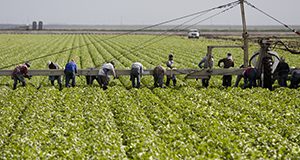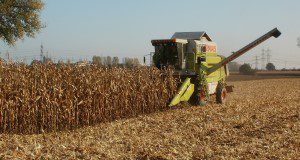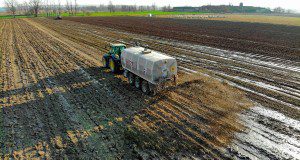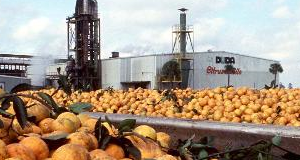Good Agricultural Practices (GAPs) and Good Handling Practices (GHPs) encompass the general procedures that growers, packers and processors of fresh fruits and vegetables should follow to ensure the food safety of their product. GAPs usually deal with preharvest practices (i.e., in the field), while GHPs cover postharvest practices, including packing and shipping. We will use the term GAPs in this fact sheet to generally cover pre- and postharvest practices associated with the safe handling of produce, both fresh and minimally processed. This five-page introduction to the Food Safety on the Farm series provides an overview of GAPs and GHPs, summarizing major principles and recommendations of later documents in the series. Written by Jaysankar De, Christopher R. Pabst, Jessica Lepper, Renée Goodrich Schneider, and Keith R. Schneider and published by the UF/IFAS Food Science and Human Nutrition Department.
http://edis.ifas.ufl.edu/fs135
Tag: Food Safety on the Farm series
Food Safety on the Farm: Good Agricultural Practices and Good Handling Practices: Transportation
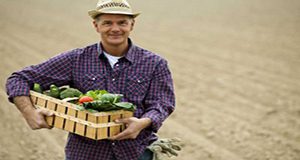
Good agricultural practices (GAPs) and good handling practices (GHPs) encompass the general procedures growers, packers, and processors of fresh fruits and vegetables should follow to ensure the safety of their product. GAPs usually address preharvest practices (i.e., in the field), while GHPs cover postharvest practices, including packing and shipping. This 3-page fact sheet covers the GAPs of transporting crops. This major revision is a part of the Food Safety on the Farm series and was written by Christopher R. Pabst, Jaysankar De, Alina Balaguero, Jessica Lepper, Renée Goodrich-Schneider, and Keith R. Schneider and published by the UF/IFAS Food Science and Human Nutrition Department.
http://edis.ifas.ufl.edu/fs151
Food Safety on the Farm: Good Agricultural Practices and Good Handling Practices: Water
Good agricultural practices (GAPs) and good handling practices (GHPs) encompass the general procedures growers, packers, and processors of fresh fruits and vegetables should follow to ensure the safety of their product. GAPs usually address preharvest practices (i.e., in the field), while GHPs cover postharvest practices, including packing and shipping. This 7-page fact sheet covers GAPs and GHPs relating to water use. This major revision is a part of the Food Safety on the Farm series and was written by Jaysankar De, Christopher R. Pabst, Jessica Lepper, Renée Goodrich-Schneider, and Keith R. Schneider and published by the UF/IFAS Food Science and Human Nutrition Department.
http://edis.ifas.ufl.edu/fs136
Food Safety on the Farm: Good Agricultural Practices and Good Handling Practices: Field Sanitation
Good Agricultural Practices (GAPs) and Good Handling Practices (GHPs) encompass the general procedures that growers, packers, and processors of fresh fruits and vegetables should follow to ensure the safety of their product. GAPs usually deal with preharvest practices (i.e., in the field), while GHPs cover postharvest practices, including packing and shipping. This 5-page fact sheet covers harvest practices associated with sanitation in the field, including basic principles for microbial food safety and control of potential hazards. This major revision is a part of the Food Safety on the Farm series and was written by Jessica Lepper, Jaysankar De, Christopher Pabst, Renée Goodrich-Schneider, and Keith Schneider and published by the UF/IFAS Food Science and Human Nutrition Department.
http://edis.ifas.ufl.edu/fs160
Food Safety on the Farm: Good Agricultural Practices and Good Handling Practices: Manure and Municipal Biosolids
Good Agricultural Practices (GAPs) and Good Handling Practices (GHPs) encompass the general procedures growers, packers, and processors of fresh fruits and vegetables should follow to ensure the safety of their product. GAPs usually deal with pre-harvest practices (i.e., in the field), while GHPs tend to cover post-harvest practices, including packing and shipping. This 5-page entry in the Food Safety on the Farm series focuses on Good Agricultural Practices, including pathogen reduction and handling and application, to control potential hazards when working with manure and biosolids. This major revision was written by Jaysankar De, Christopher R. Pabst, Jessica Lepper, Renée M. Goodrich-Schneider, and Keith R. Schneider and published by the UF/IFAS Food Science and Human Nutrition Department.
http://edis.ifas.ufl.edu/fs150
Food Safety on the Farm: Good Agricultural Practices and Good Handling Practices-Sanitary Facilities
The Food Safety on the Farm series is a collection that reviews the generally recognized principles of GAPs (good agricultural practices) as they relate to produce, primarily at the farm level and with a particular focus on fresh Florida crops and practices. This publication focuses on GAPs and GHPs (good handling practices) relating specifically to sanitary facilities. Written by Jessica A. Lepper, Aswathy Sreedharan, Renee M. Goodrich-Schneider, and Keith R. Schneider and published by the UF/IFAS Food Science and Human Nutrition Department, January 2018.
http://edis.ifas.ufl.edu/fs159
Food Safety on the Farm: Good Agricultural Practices and Good Handling Practices-Packing Operation Sanitation
The ‘Food Safety on the Farm’ series is a collection that reviews the generally recognized principles of GAPs (good agricultural practices) as they relate to produce, primarily at the farm level and with a particular focus on fresh Florida crops and practices. This publication focuses on GAPs and GHPs (good handling practices) relating specifically to packing operation sanitation. Written by Jessica A. Lepper, Aswathy Sreedharan, Renee M. Goodrich-Schneider, and Keith R. Schneider and published by the UF/IFAS Food Science and Human Nutrition Department, December 2017.
http://edis.ifas.ufl.edu/fs189
Food Safety on the Farm: Good Agricultural Practices and Good Handling Practices-Worker Health and Hygiene
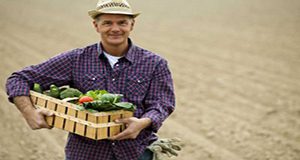
The ‘Food Safety on the Farm’ series is a collection that reviews the generally recognized principles of GAPs (good agricultural practices) as they relate to produce, primarily at the farm level and with particular focus on fresh Florida crops and practices. This 4-page publication focuses on GAPs and GHPs (good handling practices) relating specifically to worker health and hygiene. Written by Jessica A. Lepper, Keith R. Schneider, Renee M. Goodrich-Schneider, and Aswathy Sreedharan and published by the UF/IFAS Food Science and Human Nutrition Department, December 2017.
http://edis.ifas.ufl.edu/fs158
Food Safety on the Farm: Good Agricultural Practices and Good Handling Practices-Field Sanitation
The ‘Food Safety on the Farm’ series is a collection that reviews the generally recognized principles of GAPs (good agricultural practices) as they relate to produce, primarily at the farm level and with particular focus on fresh Florida crops and practices. This 4-page publication focuses on GAPs and GHPs (good handling practices) relating specifically to field sanitation. Written by Jessica A. Lepper, Aswathy Sreedharan, Renee M. Goodrich-Schneider, and Keith R. Schneider and published by the UF/IFAS Department of Food Science and Human Nutrition, December 2017.
http://edis.ifas.ufl.edu/fs160
La Seguridad en la Produccion de Alimentos en la Granja – Resumen de Buenas Practicas Agricolas (FSHN0601S/FS230)
 Las Buenas Prácticas Agrícolas (BPA) y Buenas Prácticas de Manejo (BPM) cubren los procedimientos generales que los productores, empacadores y procesadores de frutas y verduras frescas deben seguir para garantizar la seguridad de sus productos. Las BPA son usadas antes de la cosecha (es decir, en el campo), mientras que las BPM se utilizan luego de la cosecha, incluyendo el embalaje y envío. El objetivo de este panfleto es revisar los principios generalmente reconocidos como BPA en la producción de frutas y verduras frescas, sobre todo a nivel de fincas o granjas. Otros panfletos de la Extensián Cooperativa de la Florida sobre la Inocuidad de los Alimentos cubren los principios individuales en detalle, con énfasis especial en los cultivos y el manejo apropiado de los mismos en la Florida.
Las Buenas Prácticas Agrícolas (BPA) y Buenas Prácticas de Manejo (BPM) cubren los procedimientos generales que los productores, empacadores y procesadores de frutas y verduras frescas deben seguir para garantizar la seguridad de sus productos. Las BPA son usadas antes de la cosecha (es decir, en el campo), mientras que las BPM se utilizan luego de la cosecha, incluyendo el embalaje y envío. El objetivo de este panfleto es revisar los principios generalmente reconocidos como BPA en la producción de frutas y verduras frescas, sobre todo a nivel de fincas o granjas. Otros panfletos de la Extensián Cooperativa de la Florida sobre la Inocuidad de los Alimentos cubren los principios individuales en detalle, con énfasis especial en los cultivos y el manejo apropiado de los mismos en la Florida.
This 3-page fact sheet was written by Federico G. Caro, Renee Goodrich Schneider, Keith R. Schneider, y Douglas L. Archer, and published by the UF Department of Food Science and Human Nutrition, May 2013.
http://edis.ifas.ufl.edu/fs230
La Seguridad en la Produccion de Alimentos en la Granja: Buenas Practicas Agricolas y Buenas Practicas de Manejo series
 Las Buenas Prácticas Agrícolas (BPA) y las Buenas Prácticas de Manejo (BPM) abarcan los procedimientos generales que los productores, empacadores y procesadores de frutas y verduras frescas deben seguir para garantizar la seguridad de sus productos. Las BPA son usadas antes de la cosecha (es decir, en el campo), mientras que las BPM se utilizan luego de la cosecha, incluyendo el empaque y envío. Esta serie se centra en aspectos específicos del programa de BPA y cómo se relacionan con los cultivos y las prácticas de la Florida.
Las Buenas Prácticas Agrícolas (BPA) y las Buenas Prácticas de Manejo (BPM) abarcan los procedimientos generales que los productores, empacadores y procesadores de frutas y verduras frescas deben seguir para garantizar la seguridad de sus productos. Las BPA son usadas antes de la cosecha (es decir, en el campo), mientras que las BPM se utilizan luego de la cosecha, incluyendo el empaque y envío. Esta serie se centra en aspectos específicos del programa de BPA y cómo se relacionan con los cultivos y las prácticas de la Florida.
This series of fact sheets was written by Federico G. Caro, Alexandra Chang, Renée Goodrich-Schneider, y Keith R. Schneider, and published by the UF Department of Food Science and Human Nutrition, February 2013.
http://edis.ifas.ufl.edu/topic_series_spa_food_safety_on_the_farm
- Sanidad en las Instalaciones de Empaque (FSHN1205S/FS219)
http://edis.ifas.ufl.edu/fs219 - Salud e Higiene de los Trabajadores (FSHN1010S/FS220)
http://edis.ifas.ufl.edu/fs220 - Sanidad en el Campo (FSHN1012S/FS221)
http://edis.ifas.ufl.edu/fs221
Food Safety on the Farm series
 These brief fact sheets are part of a collection that reviews the generally recognized principles of GAPs as they relate to produce, primarily at the farm level and with particular focus on fresh Florida crops and practices. Written by Keith R. Schneider, Renée M. Goodrich-Schneider, and Alexandra Chang, and published by the UF Department of Food Science and Human Nutrition, March 2012.
These brief fact sheets are part of a collection that reviews the generally recognized principles of GAPs as they relate to produce, primarily at the farm level and with particular focus on fresh Florida crops and practices. Written by Keith R. Schneider, Renée M. Goodrich-Schneider, and Alexandra Chang, and published by the UF Department of Food Science and Human Nutrition, March 2012.
- Worker Health and Hygiene (FSHN1010/FS158)
http://edis.ifas.ufl.edu/fs158 - Sanitary Facilities (FSHN1011/FS159)
http://edis.ifas.ufl.edu/fs159 - Field Sanitation (FSHN1012/FS160)
http://edis.ifas.ufl.edu/fs160 - Packing Facility Sanitation (FSHN1205/FS189)
http://edis.ifas.ufl.edu/fs189
FSHN10-03/FS151 Food Safety on the Farm: Good Agricultural Practices and Good Handling Practices – Transportation
FSHN10-03, a 2-page fact sheet by Alexandra Chang, Alina Balaguero, Renée Goodrich-Schneider, and Keith R. Schneider, is part of the Food Safety on the Farm series and describes the best practices for transporting produce to avoid microbial infections, cross-contamination, and other possible hazards. Includes references. Published by the UF Department of Food Science and Human Nutrition, June 2010.
http://edis.ifas.ufl.edu/fs151
FSHN10-04/FS152 Food Safety on the Farm: Good Agricultural Practices and Good Handling Practices – Traceback
FSHN10-04, a 3-page fact sheet by Alexandra Chang, Alina Balaguero, Renée Goodrich-Schneider, and Keith R. Schneider, is part of the Food Safety on the Farm series and discusses the need for traceback requirements to identify and eliminate sources of microbial hazards, outbreaks, and food contamination. Includes references. Published by the UF Department of Food Science and Human Nutrition, June 2010.
http://edis.ifas.ufl.edu/fs152
FSHN10-02/FS150 Food Safety on the Farm: Good Agricultural Practices and Good Handling Practices—Manure and Municipal Biosolids
FSHN10-02, a 4-page fact sheet by Keith R. Schneider, Renée Goodrich-Schneider, and Alexandra Chang, is part of the Food Safety on the Farm series. It focuses on GAPs and GHPs relating specifically to manure and municipal biosolids. Includes references. Published by the UF Department of Food Science and Human Nutrition, May 2010.
http://edis.ifas.ufl.edu/fs150
FSHN06-2/FS136 Food Safety on the Farm: Good Agricultural Practices and Good Handling Practices—Water
Revised! FSHN06-2, a 5-page fact sheet by Keith R. Schneider, Renée Goodrich-Schneider, and Douglas L. Archer, is part of the Food Safety on the Farm series. It focuses on GAPs and GHPs relating specifically to water use. Includes references. Published by the UF Department of Food Science and Human Nutrition, April 2010.
http://edis.ifas.ufl.edu/fs136
